What Plants Cowboys Ate in the West
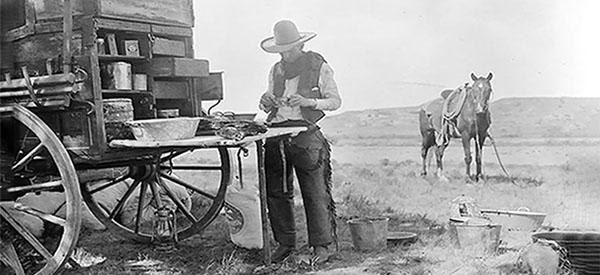
Food preservation in the days of the ol’ West wasn’t even close to what it is today. Commercially preserved food wasn’t widely available in the late 1800s when the cowboy culture was at its peak (though it did exist, surprisingly enough), and storage space was at a premium when they were on the trail, so the cowboys who rode West oftentimes made do with what was available to supplement their packable diet of dried beef and beans: wild game and edible plants.
Nomadic Diets
We all know that plant life varies from place to place. This means that, depending on where the herd took them, cowboys were forced to alter their diets to include whatever was growing locally. They didn’t stay in one place long enough to cultivate crops and produce doesn’t store well on long journeys, so they mostly relied on wild edibles to supplement their chuckwagon-diets of dried beef and beans.
Living off the plants that inhabited their current environs required a specific sort of knowledge. Chuckwagon cooks and the cowboys themselves learned from Native Americans and from other cowboys. Along with other cowboy skills like roping, driving cattle, and tending the herd, cowboys passed on their knowledge of edible plants to the new recruits.
But surviving in the wild isn’t just about basic skills—it’s about knowing how to live off the land long-term.
That’s why I rely on this guide. This isn’t your typical survival manual; it’s a practical tool that teaches you the forgotten wisdom of our ancestors who didn’t just survive in the wild – they thrived there. So, when you need to head for the hills, make sure this handbook is in your backpack; it could be your lifeline in uncertain times.
The following types of plant life were consumed on the trail, but you’ve got to keep in mind that the varieties of plants consumed varied a great deal based on region. In the desert and semi-arid western areas, for example, juicy berries and leafy greens were few and far between, but sage and cacti abounded. Cowboys might consume a completely different lineup of plants as they made their way along their routes.

Berries
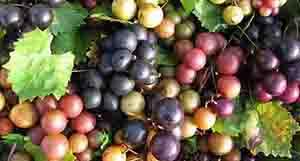
Muscadines
There are several types of wild berries that could be found across the West. Muscadines, a type of wild grape, were common cowboy fare, along with elderberries, mulberries, blueberries, blackberries, gooseberries, currants, and wild strawberries.
The availability of these wild berries was obviously very dependent on the season. Berries tend to stay on their bushes or vines for a very short period of time before they either rot or are snatched up by animals. Due to their limited availability, cowboys often brought along dried fruit. They commonly created puddings and cobblers of a sort using fruit and either biscuits of sourdough bread so that they weren’t always deprived of dessert when they were overland.
Nuts
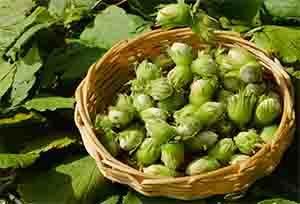
Hazelnuts
Being in the saddle all day could wear a cowboy out, and next to heavily caffeinated coffee, protein was one of the most effective ways for the cow herds to keep their energy up. This, along with the fact that they were easy to transport and prepare and were filling, led to dried beef and beans being famous for comprising the cowboy diet.
There’s more than one way to crack a nut, though, and cowboys found extra protein that didn’t make them quite as gassy in local nuts. They ate acorns (properly leached of tannins, of course), pecans, pine nuts, hazelnuts, and other types of tree nuts commonly found out west. These nuts were often roasted over an open fire and enjoyed as a tasty snack around the campfire at night, oftentimes passed around with a bottle of liquor, another cowboy staple.
extra protein that didn’t make them quite as gassy in local nuts. They ate acorns (properly leached of tannins, of course), pecans, pine nuts, hazelnuts, and other types of tree nuts commonly found out west. These nuts were often roasted over an open fire and enjoyed as a tasty snack around the campfire at night, oftentimes passed around with a bottle of liquor, another cowboy staple.

Herbaceous Greens
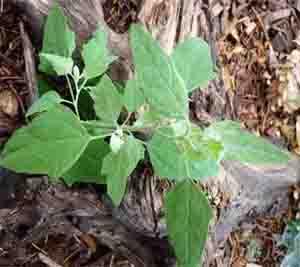
Lamb’s Quarters
While a salad of wild greens sounds like a delicious meal or side dish today, people didn’t place the same stock in the healthful nature of green vegetables in the late 19th century. Instead herbs and other tasty leafy greens were thought of more as seasoning. Local wild herbs like sage, wild garlic, and chicory.
Watercress is a commonly found and popular wild green, along with dandelion, both of which were sometimes consumed on cattle drives. Asparagus, lamb’s quarters, and chickweed were other additions to traditional cowboy ‘whistle berries’, or beans. While beans are filling, they’re not exactly the most flavorful or satisfying on their own, so these plants added flavor and variety to the Western cowboy’s diet.
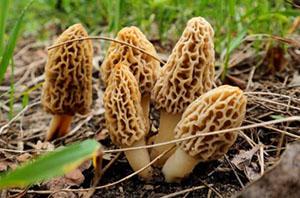
Morel Mushroom
Fungi
Though fungi weren’t as common in drier areas of the west, there were still plenty to forage. Mushrooms were commonly shunned as food source in those days due to the fact that many fungi are incredibly poisonous and look remarkably like their edible counterparts, but with a proper passing on of cowboy knowledge, many cow herds enjoyed the culinary masterpiece that is the morel mushroom or the meaty puff-ball mushroom, both commonly found in the west.

Cacti
In dessert and steppe areas along the trails of the old West, where fruit and other wild plants were few and far between, there were always cacti. Despite their spiky nature, many cacti varieties are edible, either in part or the whole plant, so long as they are prepared properly. Not only were they a viable food source, they were a refreshing, watery treat on long, hot days in the saddle.
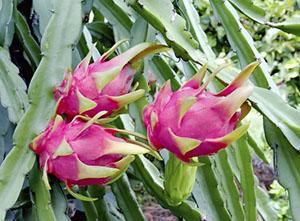
Pitaya
The prickly pear cactus, with its tasty fruit and leaves (often referred to as ‘pads’) that are perfectly edible once the spines are removed, was a favorite for cowboys in the Western states. Pitaya is also commonly consumed. Some cactus fruit can have a laxative effect, which could lead to dangerous dehydration, not to mention a really awful case of a sore hind end, so knowledge of which plants made good eating was also passed along from cowboy to cowboy.
Eventually, the development of a comprehensive railroad system out West led to an obsolete cowboy lifestyle. There was a more efficient way to drive large amounts of cattle across the country to feed a budding population from the packing plants in the western half of what is now the all the United States. Today, the cowboy way carries on in some Western states, with cowboys continuing to raise cattle on their ranches, herd them to market, and sell them to feed the booming beef industry, but much of the cowboy cuisine has gone by the wayside due to improvements in food storage and preservation techniques.
However, there are still pockets of true cowboys across the west, and though they may have access to modern foods on the trail, they’re bound to indulge in an old cowboy foraged favorite every once in a.jpg) while. In the realm of foraging, knowledge is your most potent tool. Our comprehensive guide to wild foods offers an unmatched resource for both beginners and seasoned foragers. We’ve covered everything from the basics of foraging and safety precautions to identifying, harvesting, and preparing wild edibles. So, embark on your foraging journey with confidence, knowing that you have a trusted companion in your pursuit of nature’s hidden treasures. Get your copy of the Foreger’s Guide To Wild Foods HERE
while. In the realm of foraging, knowledge is your most potent tool. Our comprehensive guide to wild foods offers an unmatched resource for both beginners and seasoned foragers. We’ve covered everything from the basics of foraging and safety precautions to identifying, harvesting, and preparing wild edibles. So, embark on your foraging journey with confidence, knowing that you have a trusted companion in your pursuit of nature’s hidden treasures. Get your copy of the Foreger’s Guide To Wild Foods HERE
Anyone can join.
Anyone can contribute.
Anyone can become informed about their world.
"United We Stand" Click Here To Create Your Personal Citizen Journalist Account Today, Be Sure To Invite Your Friends.
Humic & Fulvic Liquid Trace Mineral Complex
HerbAnomic’s Humic and Fulvic Liquid Trace Mineral Complex is a revolutionary New Humic and Fulvic Acid Complex designed to support your body at the cellular level. Our product has been thoroughly tested by an ISO/IEC Certified Lab for toxins and Heavy metals as well as for trace mineral content. We KNOW we have NO lead, arsenic, mercury, aluminum etc. in our Formula. This Humic & Fulvic Liquid Trace Mineral complex has high trace levels of naturally occurring Humic and Fulvic Acids as well as high trace levels of Zinc, Iron, Magnesium, Molybdenum, Potassium and more. There is a wide range of up to 70 trace minerals which occur naturally in our Complex at varying levels. We Choose to list the 8 substances which occur in higher trace levels on our supplement panel. We don’t claim a high number of minerals as other Humic and Fulvic Supplements do and leave you to guess which elements you’ll be getting. Order Your Humic Fulvic for Your Family by Clicking on this Link , or the Banner Below.
Our Formula is an exceptional value compared to other Humic Fulvic Minerals because...
It’s OXYGENATED
It Always Tests at 9.5+ pH
Preservative and Chemical Free
Allergen Free
Comes From a Pure, Unpolluted, Organic Source
Is an Excellent Source for Trace Minerals
Is From Whole, Prehisoric Plant Based Origin Material With Ionic Minerals and Constituents
Highly Conductive/Full of Extra Electrons
Is a Full Spectrum Complex
Our Humic and Fulvic Liquid Trace Mineral Complex has Minerals, Amino Acids, Poly Electrolytes, Phytochemicals, Polyphenols, Bioflavonoids and Trace Vitamins included with the Humic and Fulvic Acid. Our Source material is high in these constituents, where other manufacturers use inferior materials.
Try Our Humic and Fulvic Liquid Trace Mineral Complex today. Order Yours Today by Following This Link.






